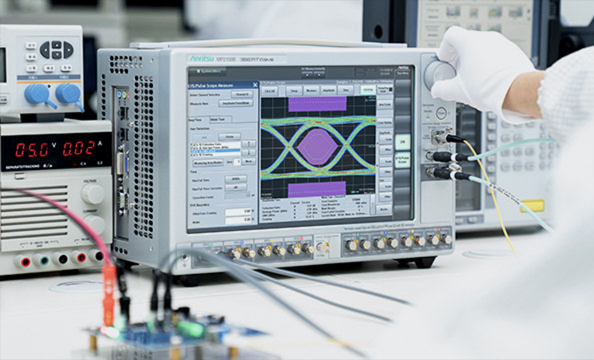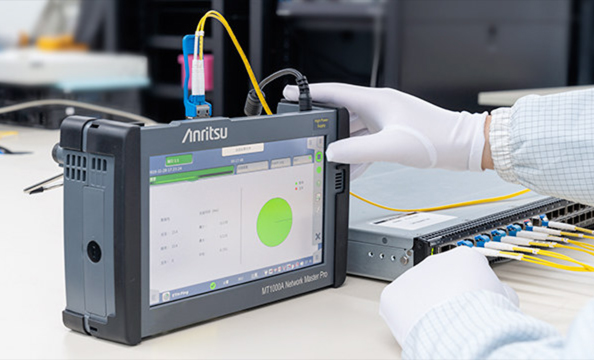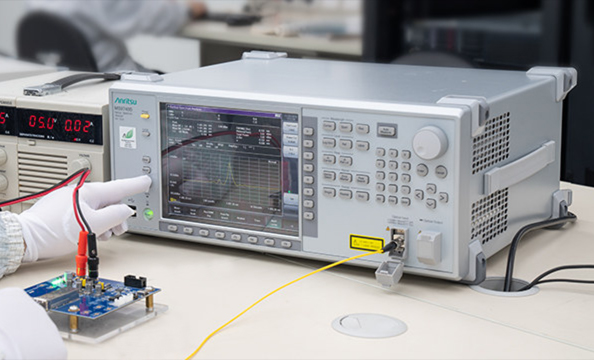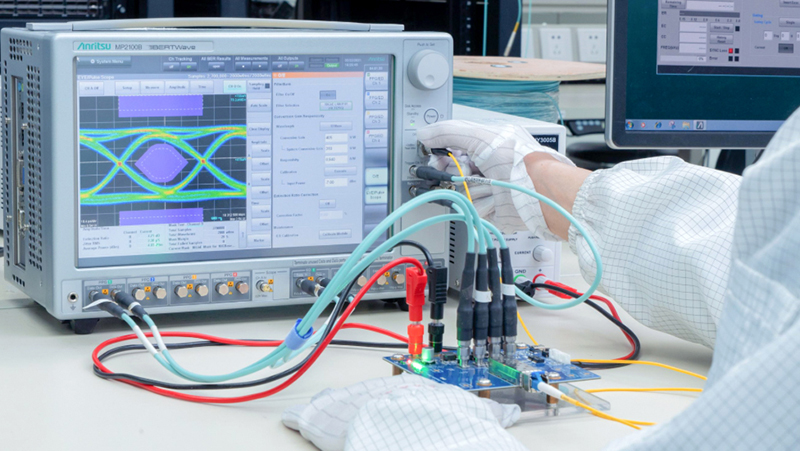




We provide efficient optical communication solutions for clients around the world, integrating research and development, manufacturing, and sales of optical modules. Currently, we offer a complete range of optical communication modules from 155M to 1.6T. Our solutions include transmission, wireless, data centers, and broadband access, aiming to create faster, more efficient, and more stable optical communication module solutions for our clients.

Providing high-performance and long-term reliable optical module solutions.
Optical modules play an essential role in the operation of data centers. A high-quality optical module can ensure the flexible operation of high-density fiber networks, providing convenience for subsequent management and expansion. So how do you select a high-quality optical module? In addition to the internal factors such as the hardware quality and compatibility of the optical module, external factors such as reliable optical module suppliers, technical support, and market trend forecasts are also important.




DDM (Digital Diagnostic Monitoring) is a technology used in optical modules that allows users to monitor real-time parameters of the optical module. These parameters include operating temperature, operating voltage, operating current, transmit and receive optical power, and can also display factory information, warning/alert notifications. Similar to it is the DOM function; DOM (Digital Optical Monitoring) allows you to monitor various data of the optical module in real-time, such as the sending and receiving, input and output power, temperature, and voltage. Network administrators can ensure that the optical module is functioning properly by viewing this data. Both DDM and DOM are monitoring methods that can help system administrators predict the lifespan of the module, isolate system faults, and detect whether the optical module is compatible. High-performance optical modules can support both functions simultaneously.
Multi-rate support refers to the ability of an optical module to operate at different data transmission rates, such as 1G, 10G, 25G, 40G, 100G, etc. This feature allows optical modules to adapt to different network environments and application requirements, providing flexible solutions. For example, within the same network architecture, users can select the appropriate transmission rate according to actual needs, satisfying high bandwidth applications while supporting compatibility with older devices. The multi-rate support function greatly enhances the scalability and flexibility of the network, especially in rapidly changing network environments, this characteristic is very popular.
Hot swapping refers to the ability to safely insert or remove optical modules without shutting down the system's power. This feature allows network administrators to replace and maintain optical modules on live network devices without interrupting network services. The hot-swappable function improves the availability and flexibility of the system, making it easier to reduce downtime when expansion or equipment replacement is needed. Additionally, the hot-swappable function is usually combined with the redundancy design of devices to ensure continuous operation and stability during module replacement. Therefore, optical modules with hot-swappable features are especially important in data centers and communication networks.
| Cisco Compatible Model | Optical Transceiver Module | Brand | WT |
| Package | SFP+, QSFP+, QSFP28, Custom | Max Transmission Rate | 10Gbps, 25Gbps, 40Gbps, 100Gbps, Custom |
| Wavelength | 850nm, 1310nm, 1550nm, Custom | Max Transmission Distance | 300m@OM3, 400m@OM4, 10km, 40km, 80km, Custom |
| Connector | Duplex LC, MPO, Custom | Fiber Type | Multi-mode, Single-mode, Custom |
| Transmitter Type | VCSEL, DFB, EML, Custom | Receiver Type | PIN, APD, Custom |
| Transmit Power | -7.3--1dBm, 0-5dBm, Custom | Receive Sensitivity | <-11.1dBm, <-18dBm, <-24dBm, Custom |
| Power Budget | 3.8dB, 10dB, 20dB, Custom | Receive Overload | -1dBm, 0dBm, Custom |
| Typical Power Consumption | ≤1W, ≤2W, ≤3.5W, Custom | Extinction Ratio | >3dB, >6dB, Custom |
| DDM/DOM (Digital Diagnostics) | Supported | Commercial Temperature Range | 0-70℃(32-158°F), -40-85℃, Custom |
| Core Size | 50/125μm, 62.5/125μm, 9/125μm, Custom | Modulation | NRZ, PAM4, Custom |
| Technical Protocols | IEEE 802.3ae, SFF-8472, SFF-8431, SFF-8432, SFP+ MSA, CPRI, eCPRI, Custom | Warranty | 5 Years |
Equipped with a professional laboratory and conducted various tests to ensure the product's compatibility, reliability, and performance.




We strictly control the quality of all products, including rigorous qualification audits of our material suppliers, a comprehensive quality management system, and production process controls that comply with certification and safety standards. Our products meet industry standards and mainstream quality certifications such as ISO 9001, CE, RoHS, REACH, FCC, FDA, CB, UL, etc.

We have a professional product R&D team and have developed multiple intellectual property rights and manufacturing technologies through independent research and development. We can provide optical modules at various rates ranging from 155Mbps to 400Gbps, including data communication optical modules: SFP, SFP+/XFP, SFP28, QSFP+, QSFP28, QSFP-DD; and various special optical modules: 10PIN, 12PIN, LCC48, LCC64, SNAP12, POB24, POB48. Currently, we have a factory area of 1860 square meters, with a 100,000-level cleanroom of 700 square meters and a 10,000-level workshop of 200 square meters.
We have passed the ISO9001 quality management system certification. Products are optimized in three stages: design, process, and process control, ensuring strict quality control. We adopt a process management system, with all product production processes clearly defined. Most components to finished products utilize automated testing and debugging methods, ensuring product consistency, reducing human errors, and achieving a factory yield rate of over 99%. We are continuously striving towards a "zero defect" quality goal!
We focus on the products themselves, introducing and absorbing advanced technologies from the industry, and have built a professional, stable, and experienced R&D team. Most of our R&D engineers have over 8 years of experience in optical device development. R&D personnel account for 15% of the total number of employees, with electronic engineers making up 60%, structural engineers 25%, and software engineers 15%. To better adapt to market trends and meet customer demands, the company invests more than 15% of its annual sales revenue into new product development. All of the company's products are independently developed and hold complete independent intellectual property rights. The company already possesses multiple industry-leading utility model patents and software copyright registrations.
What factors affect the transmission distance of optical modules?
The transmission distance of optical modules is influenced by factors such as fiber type, wavelength, output power, receiver sensitivity, environmental temperature, and connector quality. Single-mode fibers are generally suitable for long-distance transmission, while multi-mode fibers are suited for short distances.
100M Optical Module
How is the signal attenuation calculated for 100G/400G/800G optical modules?
Signal attenuation is typically calculated in decibels (dB) and primarily depends on the fiber's attenuation coefficient, transmission distance, and connection loss. The attenuation formula is: Total Attenuation (dB) = Distance (km) × Attenuation Coefficient (dB/km) + Connection Loss (dB).
100G/400G/800G Optical Modules
How do you choose the right optical module to meet network bandwidth requirements?
When selecting an optical module, consider the network's bandwidth requirements, transmission distance, and fiber type. Usually, you need to select a suitable rate (such as 100G, 400G, etc.) based on current and future traffic demands.
100G/400G/800G Optical Modules
What impact do temperature characteristics of optical modules have on performance?
The operating temperature range of an optical module is critical for its performance. Exceeding this range may lead to gain reduction, signal distortion, or even module failure. Thus, it is essential to select optical modules suitable for the environmental temperature.
100G/400G/800G Optical Modules
How do different types of fiber affect the compatibility of optical modules?
Single-mode optical modules are typically compatible with single-mode fibers, suitable for long-distance transmission; multi-mode optical modules are compatible with multi-mode fibers, suitable for short-distance applications. Choosing incompatible optical modules and fibers may result in signal loss or malfunction.
100G/400G/800G Optical Modules
How do you evaluate the power consumption and heat dissipation performance of optical modules?
The power consumption of an optical module can be obtained from the parameters provided in its datasheet. Heat dissipation performance needs to consider the module's design and the surrounding temperature to ensure the module's operating temperature does not exceed its specifications.
100G/400G/800G Optical Modules
What role does the DSP chip play in optical modules?
The Digital Signal Processor (DSP) in optical modules is used for signal modulation, demodulation, equalization, and error correction, improving transmission quality and extending transmission distance. DSP effectively suppresses signal distortion and noise.
100G/400G/800G Optical Modules
How can the reliability of optical modules be ensured in high-temperature environments?
To ensure the reliability of optical modules in high-temperature environments, it is necessary to choose industrial-grade optical modules and ensure a good heat dissipation design. Regular monitoring of the module's operating status is also essential.
100G/400G/800G Optical Modules
How do you diagnose and troubleshoot optical module faults?
Fault diagnosis usually involves checking the optical module's indicator lights, measuring signal strength with an optical power meter, and inspecting the cleanliness and damage of connectors and fibers. Using network monitoring tools can help quickly locate faults.
100G/400G/800G Optical Modules
What are the specific application scenarios for multi-mode and single-mode optical modules?
Multi-mode optical modules are commonly used in data centers, local area networks, and short-distance applications, while single-mode optical modules are suitable for long-distance transmission, such as wide area networks and metropolitan area networks. Consider application needs and budgets when choosing.
100G/400G/800G Optical Modules
What technology is typically used for the light source in optical modules?
The light source in optical modules typically uses Laser Diodes (LD) or Light Emitting Diodes (LED). Laser diodes are suitable for long-distance and high data rate applications, while LEDs are more commonly used for short-distance and low-speed applications.
100G/400G/800G Optical Modules
What impact does the wavelength selection of optical modules have on performance?
The wavelength selection of optical modules directly affects transmission loss and distance. Generally, longer wavelengths (such as 1550nm) are suitable for long-distance transmission, while shorter wavelengths (such as 850nm) are suitable for short distances.
100G/400G/800G Optical Modules
What standardized protocols exist for optical modules?
Common standardized protocols for optical modules include SFP, SFP+, QSFP, QSFP+, and CFP. These standards define the size, interface, and performance requirements of optical modules to ensure interoperability between products from different manufacturers.
100G/400G/800G Optical Modules
How can the link performance of optical modules be optimized?
Methods to optimize the link performance of optical modules include using high-quality fibers and connectors, minimizing bends and stretches, ensuring connector cleanliness, and regularly monitoring link status to address faults timely.
100G/400G/800G Optical Modules
How do you evaluate the compatibility of optical modules?
Evaluating the compatibility of optical modules involves considering the compatibility list from device manufacturers, the standard specifications of the optical module, and the supported protocols to ensure compatibility with existing network equipment.
100G/400G/800G Optical Modules
How is the MTBF (Mean Time Between Failures) of optical modules calculated?
MTBF is typically calculated by statistically analyzing the frequency of failures of optical modules under specific conditions, usually expressed in hours. Manufacturers provide MTBF parameters based on testing data.
100G/400G/800G Optical Modules
What is the self-test function of optical modules?
The self-test function of optical modules allows them to check their functional status during startup, including temperature, output power, and receiver sensitivity, ensuring they operate under normal conditions.
100G/400G/800G Optical Modules
How are EMI (Electromagnetic Interference) issues addressed in optical modules?
To address EMI issues in optical modules, measures such as shielding design, optimizing PCB layout, and using low-EMI materials can be employed to ensure that optical modules operate normally in electromagnetic interference environments.
100G/400G/800G Optical Modules
How do you evaluate the market adaptability of optical modules?
To evaluate the market adaptability of optical modules, analyze industry trends, target market demands, competitor products, customer feedback, and technological innovations across multiple dimensions.
100G/400G/800G Optical Modules
How does the manufacturing process of optical modules impact performance?
The manufacturing process of optical modules directly affects their performance, reliability, and cost. High-precision manufacturing processes can effectively reduce the defect rate of optical modules and improve their long-term stability.
100G/400G/800G Optical Modules